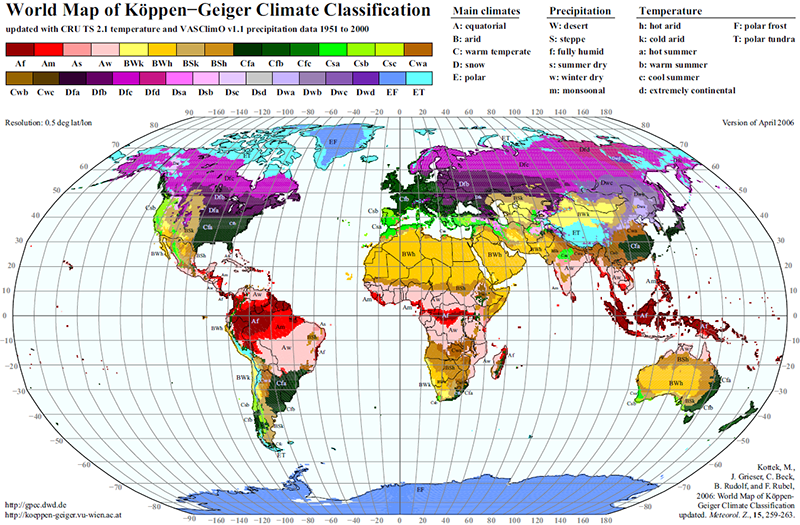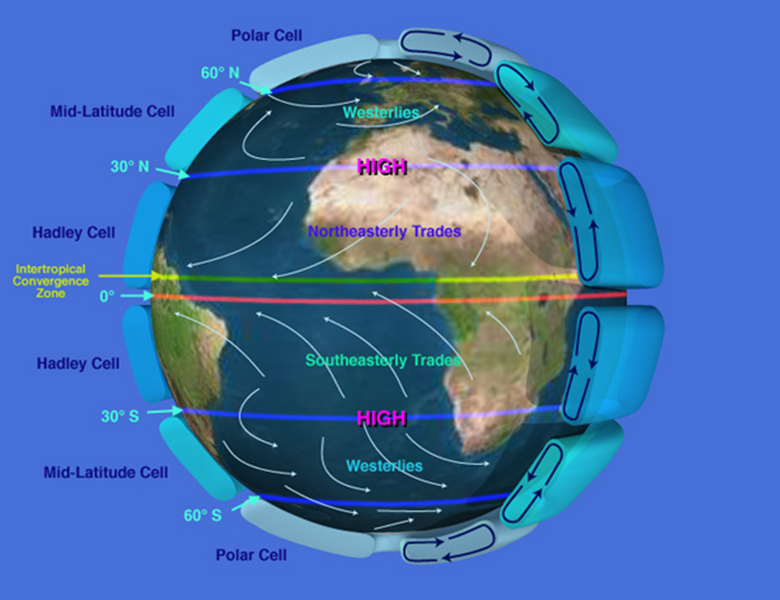Climate is what you expect, weather is what you get.
Mark Twain
(Samuel Clemens, 1835-1910)
American author and humorist
Climate controls the biomes of our world. It explains why we have luscious, green tropical rainforests in some regions and arid, barren deserts in others. Climate is the variability and variation in weather for a particular region over time. This includes regular weather conditions as well as extremes. Temperature and precipitation are two of the main factors influencing climate, but latitude, topography, and soil also affect climate. Climate helps to explain the distribution of plants, animals, and soils around the world, and is obviously critically important for understanding the distribution patterns of freshwater on Earth.
The Köppen Climate Classification System divides the world into five major climate types based on average monthly temperatures, average monthly precipitation, and total annual precipitation. It is the most widely used system for climate classification. The five major types of climates are designated by the capital letters, A, B, C, D, E, or H. A - represents humid tropical climates, B - represents dry climates, C - represents mild mid-latitude climates, D - represents severe mid-latitude climates, E - represents polar climates, and H – represents highlands or mountainous areas, where climate can vary due to elevation or slope aspect differences. These categories are then subdivided based on temperature and precipitation, and borders between regions represent transition zones between climate types (see Table 1 at the end of the lesson for detailed subtypes).
The German climatologist and amateur botanist Wladimir Köppen(1846-1940) introduced this system in 1928, which was co-authored with his student Rudolph Geiger. Köppen continued to update their system until his death. It remains the primary climate classification system in use in the world today. Kottek et al. (2006) provides a recent update (Figure 5.1).

World Map of the Köppen-Geiger climate classification updated.
Meteorol. Z., 15:259-263. DOI: 10.1127/0941-2948/2006/0130.)
To further understand how the Köppen climate types are formed, it is important to become familiar with global atmospheric and oceanic currents. Global winds drive the surface ocean currents, which also are influenced by the Coriolis Force caused by Earth’s rotation. The Inter-Tropical Convergence Zone (ITCZ) is a part of the global circulation system that generates large amounts of precipitation. It is a low- pressure zone near the equator that is caused by the convergence of trade winds. This convergence results in a stagnation of winds, even though the actual location of the ITCZ varies from year to year. This shifting in location helps to create the wet and dry seasons of the tropics. It is sometimes known as the thermal equator. The systems that create these trade winds are known as Hadley Cells. These cells are formed when warm air rises near the equator and moves towards the poles. This warm air is a result of the sun’s uneven insolation, so the tropical regions absorb more heat than they reflect, compared to the surrounding regions (Figure 5.2).
In Figure 5.2, the Earth is rotating left to right, or eastward, in this figure, creating the Coriolis Force, which drives, in part, the “spin” of these currents. This can be seen by the directional movement of the trade winds in both the northern (clockwise, right) and southern (counterclockwise, left) hemispheres. The ITCZ varies in its position around the equator by season and as a consequence of atmospheric and oceanic currents. The Hadley Cells form as hot, moist air rises in the vicinity of the equator. Other cells, somewhat weaker, set up similar patterns toward the poles. More information can be found on the web links on the following Resource Material page.

